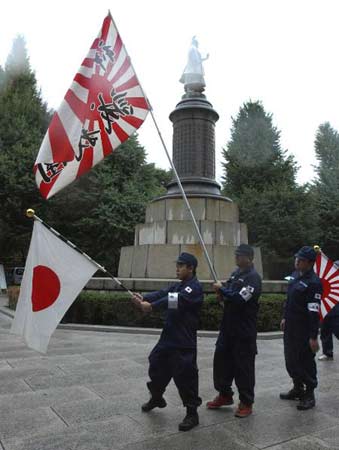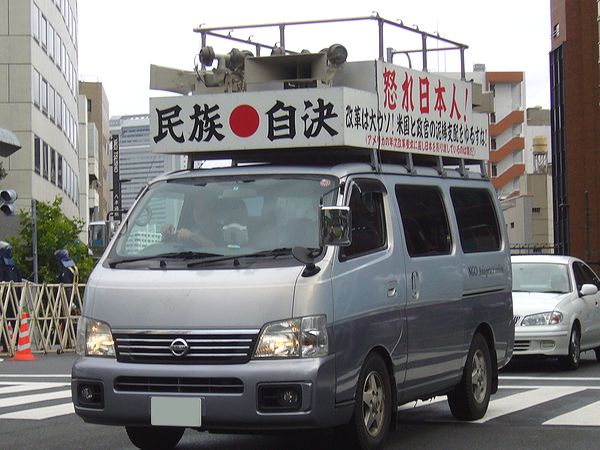Japan's new right wing is old stuff

Japan's new right-wing group, Issuikai, hosted the leaders of nine European right-wing political parties from eight different nations for a summit and tribute to the controversial Yasukuni Shrine.
"We are all patriots," Issuikai leader Kimura Mitsuhiro said of the summit. "We all opposed the US-initiated Iraq war and the international system built and led by the United States after World War II, and we all think the Tokyo trials were not fair."
The summit served as a "patriot rally" for "bringing world peace," and the leaders agreed on topics such as opposing immigrants and globalization, with much of their attacks directed at the U.S.
Japan's right wing has been active in recent years. They've placed their bets on nationalism and national interest and combine it with harsh words that unequivocally state their anti-US and anti-West sentiment. But these "new" right wingers haven't separated themselves from past right-wing rhetoric and organizations.
Kimura has doubted the casualties of Nanjing Massacre and the historical facts of the tragedy, and he still believes the remains of any soldiers who died in the war should go to Yasukuni Shrine for tribute. He completely ignores Japan's war crimes.
What exactly makes this right-wing new? Some right wingers have said a more appropriate term would be "emperor wing," as their most prominent feature is absolute loyalty to the emperor.
Japan's right wing groups reflect some political appeal from lower society. Their major theories are anti-system, anti-government, anti-Westernism, nationalism, and they promote a robust, meaningful role for the emperor. If we look back with a historical perspective, these theories are closely tied with the basic theories that prompted Japan to militarize.
In 1878, Toyama Mitsuru and Hiraoka Kotaro established Koyosha, which was turned into the world famous Genyosha (Black Ocean Society) in 1881. Three rules were set up by the Genyosha: respect, love and loyalty to the Emperor and his family; deep love for the nation; and defense of people's rights. Genyosha then evolved into the Kokuryukai (The Black Dragon Society), Ronin Society, the Dai Nippon Seianto (Greater Japan Production Party), and Daitōjuku – all of which formed the genesis of Japan's right wing.
In 1919, Dai Nihon Kokusuikai (Greater Japan National Essence Society) was established. Compared to Genyosha and Kokuryukai, Dai Nihon Kokusuikai was called the action-oriented right wingers. During the Taisho-democracy era, Western ideas poured in, the right wing reformists reacted by stressing the importance of organizing movements and sought to reform the nation's political system while adhering to "self-dependant diplomacy" – meaning keeping a safe distance from Europe and the U.S. Kita Ikki, a prominent figure of action-oriented right wing, established the short-lived Survivor's Society in 1919. He proclaimed to "reform the Empire of Japan and liberate Asia's peoples."

Shortly after World War II, the traditional Japanese right wing suffered significant damage. Under the influences of the governments of Japan and the U.S., the major feature of the post-war right wing groups was pro-US and anti-Communism." In 1970, after Mishima Yukio committed suicide, the nationalist, right-wing forces took the stage. They wanted to return to the origins of the right wing and inherit the traditions of its ideologies and movements.
In 1972, Suzuki Kunio established the major right-wing group Issuikai. Their political ideology denied the post-World War II era's Yalta system, called for independence when dealing with the U.S., promoted a more-than-symbolic emperor, opposed politically exploiting the emperor, and proclaimed to "unite all the peoples in the world." It appeared new in some ways, but it still had the tone of the original right wing.
Even though there are not so many people in new right-wing groups, their political ideologies reflect the social psyches of a certain portion of Japanese people, and their influence has started to grow. Maybe this is one issue we should pay attention to when we observe the China-Japan relationship.
The author is a researcher with the Institute of Japanese Studies, Chinese Academy of Social Sciences.
(This post was first published in Chinese and translated by Keen Zhang.)
 0
0 






